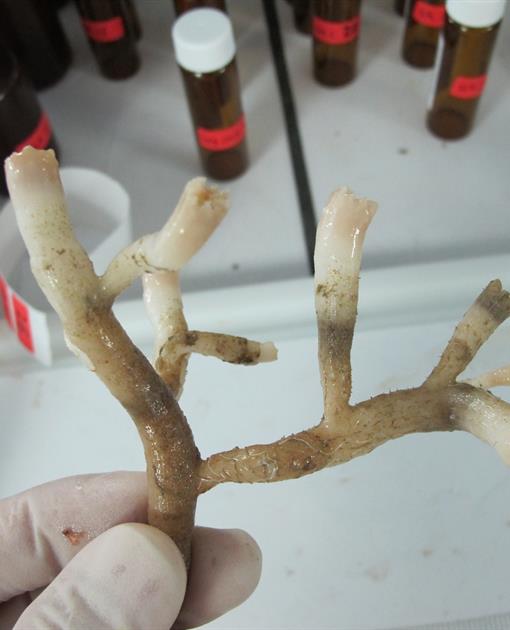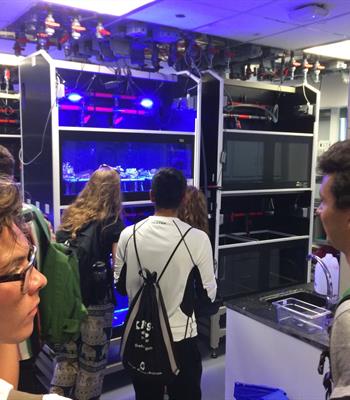About Marine Science Research at KAUST
 with state-of-the-art facilities and world-class researchers. With its striking blue waters in our backyard, the Red Sea represents KAUST’s most unique ‘laboratory’. The Red Sea Research Center undertakes a wide variety of research to formulate a comprehensive understanding of the Red Sea’s rich ecology. This knowledge is crucial to ensure sustainable use and conservation of its natural resources.
with state-of-the-art facilities and world-class researchers. With its striking blue waters in our backyard, the Red Sea represents KAUST’s most unique ‘laboratory’. The Red Sea Research Center undertakes a wide variety of research to formulate a comprehensive understanding of the Red Sea’s rich ecology. This knowledge is crucial to ensure sustainable use and conservation of its natural resources.This unique sea supports enormous diversity in the form of many species of fishes, invertebrates, seaweeds, phytoplankton, and bacteria. The Red Sea hosts coral reefs, mangroves, seagrasses, brine pools, and other important ecosystems. The incredible biodiversity of the Red Sea holds untapped potential for understanding globally-significant questions, particularly with regard to evolutionary biology, stress tolerance, and adaptation to extreme environments.
Studies conducted by scientists within, and in collaboration with, the Red Sea Research Center have already broken the boundaries of current marine research and are making waves in the field. The Red Sea Research Center is intimately linked with the Marine Science degree program and other BESE degree programs. Learn more here
About Biological and Environmental Science and Engineering (BESE) Division
Research in BESE is focused on the molecular and cellular mechanisms through which organisms sense, adapt and respond to the environment and to the development of innovative technologies that provide support to this mission.
 At the more applied level, research projects in the Division center on how to intervene on the environment to respond to the increasing needs of food and water availability, how human activity affects environmental systems at an integrated level and how such interventions, in turn, affect living organisms.
At the more applied level, research projects in the Division center on how to intervene on the environment to respond to the increasing needs of food and water availability, how human activity affects environmental systems at an integrated level and how such interventions, in turn, affect living organisms.
BESE boasts state-of-the-art facilities and resources, including some of the most advanced equipment in the world for genomics, proteomics, imaging/characterization, nanofabrication, and capability to explore global marine environments.
Research at the BESE Division brings students, faculty, and researchers together to push the frontiers of science through collaborative inquiry into issues of global and regional significance.
In order to accomplish its mission and establish a knowledge and advanced technology platform, research in the BESE Division is developed around seven research fields. These research fields are communities of faculty that work in related areas and are divided further into more specialized topics of research.
The BESE Division has two affiliated Research Centers: the Red Sea Research Center and the Water Desalination and Reuse Center. KAUST Research Centers invest in major projects and provide thematic focus and critical mass to pursue goal-oriented research that addresses significant challenges for the Kingdom and the world.
The BESE division has also engaged in three research initiatives: BioNEST from bench to innovation (Neuroscience, Epigenetics, Stem Cell biology), Environmental Epigenetics program and Desert Agriculture initiative.
Education is provided through four programs: 1) Bioscience, 2) Marine Sciences, 3) Environmental Sciences and 4) Plant Sciences.
About KAUST
Established in 2009, King Abdullah University of Science and Technology (KAUST) is a graduate-level research university located on the shores of the Red Sea in Saudi Arabia.
KAUST is dedicated to advancing science and technology through interdisciplinary research, education and innovation.
Curiosity-driven and goal-oriented research is conducted by students, faculty, scientists and engineers to address the world's pressing scientific and technological challenges related to food, water, energy and the environment.
Our students come from over 80 countries and our faculty from over 35. Simply put, we believe that cultures working together produce more effective solutions than cultures working in isolation.
An interdisciplinary approach combines science and engineering while bringing perspectives from a variety of specializations together to discover innovative solutions to fundamental problems.